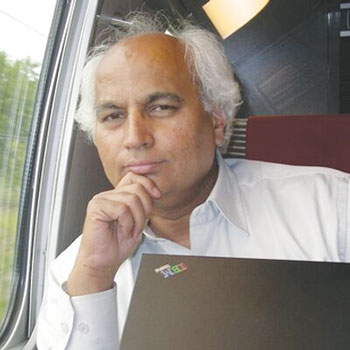
Therefore, whenever I try to explain to people that the objective of my Forum for a New South Asia is to promote a ‘peace triangle’ connecting India, Pakistan and China, the usual reaction is — “it’s a pipe dream”. Lijian, whom I met in Islamabad last year, is an exception who supports the forum.
When people dismiss a good idea as unworkable, one is naturally stimulated to translate it into reality. The objective of the India-Pakistan-China ‘peace triangle’ is to ultimately expand it into a greater ‘peace circle’ that will eventually cover the entire world and secure a future without wars and violence for humanity. As a Hindu, from my childhood I have heard the chanting of the shanti mantra which urges us to create shanti (peace) on pruthvi (earth), in aap (water), vanaspati (flora and fauna), and antariksh (space)… indeed everywhere. Similar lofty peace hymns can be found in every religion and culture around the world. Then why such deeply entrenched skepticism about the most fundamental canons of all religions and humanistic philosophies?
One of the main reasons behind widespread skepticism about attaining global peace and harmony can be traced back to the formal and non-formal education we receive in childhood. Our education begins with education of the heart imparted by our mothers. However, as we grow, efforts to develop the heart recede into the background and the focus shifts almost entirely to development of the brain. The heart is where we experience love and peace. Balanced and harmonious development of heart and brain prompts us to find practical ways to expand the circle of love and peace — from our own family to the community, to the neighbourhood, the nation and, ultimately, to the entire human family. However, when only the brain develops and the heart shrinks, human beings forget about love and harmony, allowing the baser instincts of human nature to dominate their personalities.
Indeed, that is what’s happening today in local and global contexts. People have begun to believe that selfishness, hatred, hostility, conflict and violence are ineradicable and intrinsic to human existence. Barely is one conflict or conflagration resolved, when new conflicts arise proving that the genus homo sapiens hasn’t developed the power to ensure sustainable peace. Human history is strewn with numerous tragic examples of this failing. This is because the only power that can make peace sustainable is the power of the heart, the power of love. Mahatma Gandhi perceptively described love as the active form of non-violence. In his education philosophy he attached far greater importance to the nurturing power of the heart than to training the faculties of the head. Sadly, it’s just the opposite in our formal education system.
Therefore, if we want a better future for our neighbourhood, for India and humanity, we must rediscover ways of educating hearts right from the moment of birth. Indeed, this miracle begins when we are still in our mothers’ wombs. The craving of yet-to-be-born children for their mothers hearts, and the mysterious ways in which every mother’s heart provides love, peace and reassuring security to the new life that is her gift to the world, should be a subject of deep investigation and research.
Let me again bring Lijian Zhao into our discussion. He recently sent me a video clip which has gone viral globally — broadcast on CCTV, China’s government-owned television network. It features a new born child whose mother died during her birth. The mother’s heart was donated to a man — a wonderful example of the need to popularise organ donation. Tragically torn from her mother, a large number of people vainly attempted to comfort this constantly morose child. However, in this narrative her face blossoms into a beautiful smile when the man who received the deceased mother’s transplanted heart, holds the baby to his chest. The child recognised the mother’s heartbeat. (Watch this video on YouTube at https://www.youtube.com/watch?v=Fa_B2nJoBZE.)
Today our world is like that grieving child eagerly craving the comfort of her mother’s heart and the magical qualities of love, care and compassion it embodies. Indeed, we have built a world that has made amazing progress in wealth accumulation and violence, but one that is woefully deficient in peace and harmony. Pope Francis has warned that humanity of the 21st century is suffering because of the “globalisation of indifference”. All of us and particularly teachers, need to do our utmost to globalise liberty, equality and fraternity. The precondition of this transformation is global-scale education of the human heart.
(Sudheendra Kulkarni served as an aide of India’s former prime minister Atal Bihari Vajpayee)